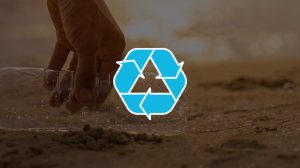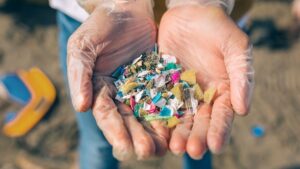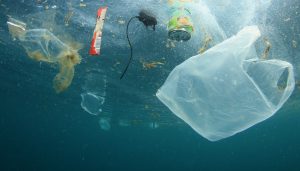Cigarette butts pose big microplastic hazard in the oceans
You’ve seen it before: A driver idling at a stoplight flicks a cigarette butt out the window or a worker during a smoking break drops one to the sidewalk.
What you don’t see is what happens to those cigarette butts.
Typically, rain sweeps them down storm drains, into local waterways and, eventually, into the Chesapeake Bay or the Atlantic. There, those tough little cigarette filters—made of tightly packed plastic fibers—start to erode into smaller and smaller plastic bits, joining a cascade of microplastic pollution that’s bedeviling the world’s oceans and the living things they support.
Microplastics may be small, but their impact is far from it.
“Viruses aren’t big, either,” said Robert Hale, who studies microplastic pollution at the Virginia Institute of Marine Science in Gloucester Point. “So the idea of something small being not a problem is actually completely 180 degrees from reality.”
Plastic bags, balloons and water bottles pose one threat when they’re ingested by sea turtles, fish and waterbirds that mistake them for food.
But microplastics—or, more accurately, micro shards—get gobbled up by the tiniest creatures that form the base of the marine food web. Some pieces are so tiny that they can pass through cell membranes.
Those micro shards climb the food chain, compounding the damage and the dangers along the way.
For over 20 years, cigarette butts have been the No. 1 debris item reported in Virginia during coastal cleanups, according to Katie Register, executive director of Clean Virginia Waterways of Longwood University.
Register wrote the 2016 Virginia Marine Debris Reduction Plan for the Coastal Zone Management Program at the Department of Environmental Quality.
That finding bears out whenever VIMS faculty and student volunteers conduct a beach cleanup. In less than a mile of shoreline over less than an hour, volunteers can pick up more than 3,000 cigarette butts—far outpacing the number of plastic food wrappers from a recent cleanup (981), fast food containers (15), foam packaging (60) and bottles (6).
“I would imagine many people are working under the assumption that cigarette butts are biodegradable,” said Meredith Evans Seeley, a doctoral student studying plastics in Hale’s lab.
“I think many people believe that they break down into the environment and break down fully, so that they’re not causing any harm.”
Plastics can last seemingly forever, and they’re everywhere.
Earlier this year, scientists said they’ve found tiny plastic particles raining from the sky in such pristine areas as the Pyrenees Mountains in southern France, and in the deepest depths of the oceans, where tiny bottom-dwelling creatures routinely eat them.
“We can now say with confidence that plastic is everywhere,” Alan Jamieson, marine biologist at Newcastle University in England and lead author of the deep ocean microplastics study, told National Geographic in February.
Hale and Seeley, for instance, and their colleague Patty Zwollo, biology professor at the College of William and Mary, have studied microplastics—and the chemical additives leaching out of them—that wash up even in remote parts of Alaska.
Pristine estuaries there, said Seeley, receive huge loads of plastics from the Pacific Ocean.



